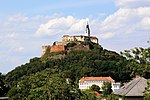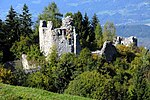
The House of Habsburg, also known as the House of Austria, is one of the most prominent and important dynasties in European history.
Duke of Burgundy was a title used by the rulers of the Duchy of Burgundy, from its establishment in 843 to its annexation by France in 1477, and later by Holy Roman Emperors and Kings of Spain from the House of Habsburg who claimed Burgundy proper and ruled the Burgundian inheritance in the Low Countries.
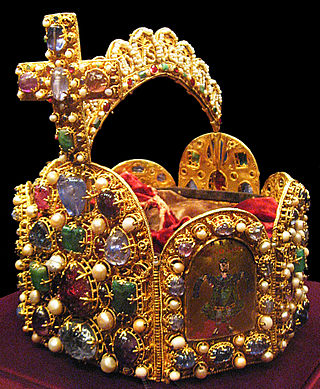
The Imperial Crown of the Holy Roman Empire, a hoop crown with a characteristic octagonal shape, was the coronation crown of the Holy Roman Emperor, probably from the late 10th century until the dissolution of the Holy Roman Empire in 1806. The crown was used in the coronation of the King of the Romans, the title assumed by the Emperor-elect immediately after his election. It is now kept in the Imperial Treasury at the Hofburg in Vienna, Austria.
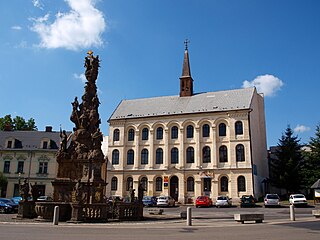
Zákupy is a town in Česká Lípa District in the Liberec Region of the Czech Republic. It has about 3,000 inhabitants. The historic town centre with the castle is well preserved and is protected by law as an urban monument zone.

Laxenburg is a market town in the district of Mödling, in the Austrian state of Lower Austria. Located about 20 km (12 mi) south of the Austrian capital Vienna, it is chiefly known for the Laxenburg castles, which, beside Schönbrunn, served as the most important summer retreat of the Habsburg monarchs.

The Residenz in central Munich is the former royal palace of the Wittelsbach monarchs of Bavaria. The Residenz is the largest city palace in Germany and is today open to visitors for its architecture, room decorations, and displays from the former royal collections.

Maria am Gestade is a Gothic church in Vienna, Austria. One of the oldest churches in the city—along with St. Peter's Church and St. Rupert's Church—it is one of the few surviving examples of Gothic architecture in Vienna. Located in the Innere Stadt at Salvatorgasse 12, near the Donaukanal, the church was traditionally used by sailors on the Danube river. The name reflects the former location on the Fluvial terrace of an arm of the Danube river, prior to its regulation.
Due to the stairs surrounding the church it got the popular name Maria Stiegen.

Schloss Hetzendorf is a baroque palace in Hetzendorf, Meidling, Vienna, that was used by the imperial Habsburg family.

Laxenburg castles are imperial palaces and castles outside Vienna, in the town of Laxenburg owned in equal parts by Vienna and Lower Austria. The castles became a Habsburg possession in 1333 and formerly served as a summer retreat, along with Schönbrunn palace, for the imperial Habsburg dynasty. Blauer Hof Palace was the birthplace of some members of the royal family, including Crown Prince Rudolf. Another castle nearby is named Franzensburg castle.

The ruins of Falkenstein Castle is in the Weinviertel region of Lower Austria, about 55 kilometres (34 mi) north of Vienna near the border to Czech Republic.

Schloss Esterházy is a palace in Eisenstadt, Austria, the capital of the Burgenland state. It was constructed in the late 13th century, and came under ownership of the Hungarian Esterházy family in 1622. Under Paul I, 1st Prince Esterházy of Galántha the estate was converted into a baroque castle which remained the principal residence and center of administration of the family for over 300 years.

Tivoli Castle, originally called Podturn Manor, is a mansion in Ljubljana, the capital of Slovenia.

The Château de Kintzheim is a castle in the commune of Kintzheim in the Bas-Rhin département of France dating from the 12th century. The ruin of the castle dominate the village of Kintzheim.

Landskron Castle is a medieval hill castle northeast of Villach in the state of Carinthia, Austria. Dating to the early 14th century, the castle ruins are located on a rock cone of the Ossiach Tauern range, at an elevation of 658 metres (2,159 ft) above sea level. Today Landskron Castle, its falconry centre conducting regular flying demonstrations, and the nearby macaque enclosure are major tourist destinations.

Neugebäude Palace is a large Mannerist castle complex in the Simmering district of Vienna, Austria. It was built from 1569 onwards, at the behest of the Habsburg Emperor Maximilian II. The site of the palace is said to be where the Ottoman Sultan Suleiman the Magnificent's tent was erected during the 1529 Siege of Vienna. The palace was apparently modeled after it.

The Moszna Castle is a historic castle and palace located in the small village of Moszna, in southwestern Poland. Situated approximately 30 kilometres (19 mi) south of the regional capital Opole, between the towns of Prudnik and Krapkowice, the residence is an excellent example of romantic fairy-tale and eclectic architecture.
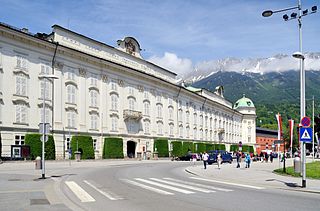
The Hofburg is a former Habsburg palace in Innsbruck, Austria, and considered one of the three most significant cultural buildings in the country, along with the Hofburg Palace and Schönbrunn Palace in Vienna. The Hofburg is the main building of a large residential complex once used by the Habsburgs that still includes the Noblewomen's Collegiate Foundation, the Silver Chapel, the Hofkirche containing Emperor Maximilian's cenotaph and the Schwarzen Mandern, the Theological University, the Tyrolean Folk Art Museum, Innsbruck Cathedral, the Congress, and the Hofgarten.

Schloss Weinzierl is a castle in Weinzierl, near Wieselburg/Erlauf in the southwestern Mostviertel region of Lower Austria, located in a park. The essential components of the existing building date to the early 18th century' on earlier foundations. The four-winged castle encloses a courtyard including arcades and corner towers in late-baroque style. The complex also includes an original early Baroque church with post-gothic elements.
The Cour Carrée is one of the main courtyards of the Louvre Palace in Paris. The wings surrounding it were built gradually, as the walls of the medieval Louvre were progressively demolished in favour of a Renaissance palace.


























